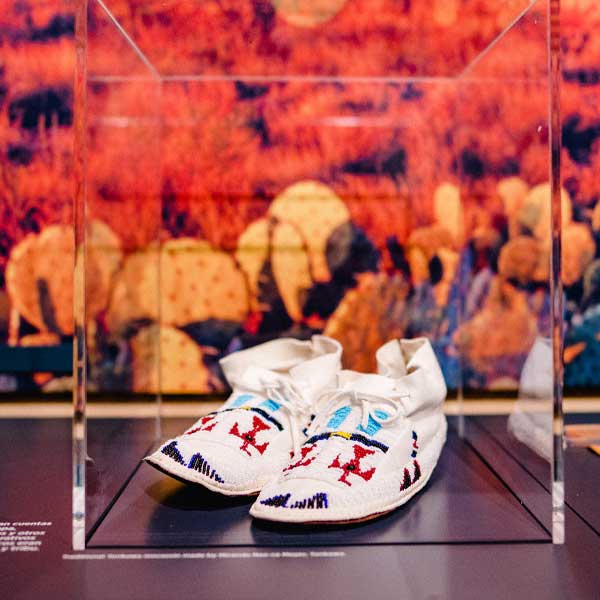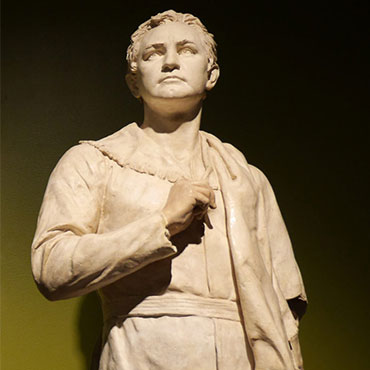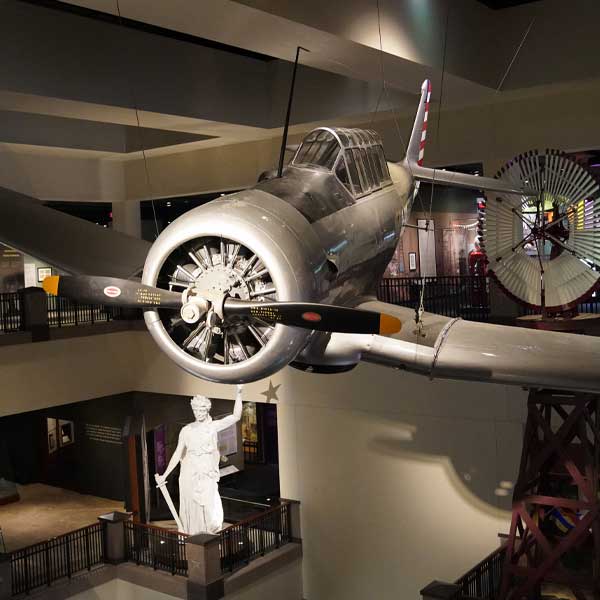Texas History Galleries
Immerse yourself in the Story of Texas
With expansive exhibition space showcasing more than 700 original artifacts, discover an ever-changing experience in the Texas History Galleries. Artifacts are continually added, bringing new stories to the Museum each week.
Your museum admission purchase supports the Bullock Museum's exhibitions and educational programming.
First Floor Gallery
The first floor gallery features Becoming Texas, a one-of-a-kind journey through Texas’s earliest history from its first inhabitants to Mexican Independence in 1821. Incised stones from central Texas date to 12,000 years ago; they are among the earliest known objects that speak to artistic expression of this region. Since that time there has been a steady stream of people calling Texas home. Early Indigenous groups developed complex trade networks making it possible for abalone and Glycymeris shell from the West Coast, turquois from the Southwest, and other materials from across North and South America to end up in Texas.
European explorers arrived in the 16th century seeking gold and other riches. The centerpiece of the gallery is the French ship La Belle that was part of La Salle’s attempt to establish a colony along the Texas coast. The Spanish followed the French, building Catholic missions like Mission Valero. Two rare gates believed to be from the mission are on view, as well as other artifacts that help us imagine life in 17th century Texas.
While the Spanish were struggling to stake a claim to the region, the land was really dominated by American Indian groups. Their interactions with each other and the Europeans they encountered led to partnerships and conflict. A musket traded by the French to American Indians to use against the Spanish highlights the competing interests of the 18th century. As those interests became more complex in the early 19th century, Texas increasingly impacted and was impacted by global events culminating in Spain losing Texas when Mexico declared its independence in 1821. Some families in Texas can trace their roots directly back to these very early days of Texas settlement. Their stories have a home in the gallery as well.
Second Floor Gallery
The second floor gallery is bookended by two gleaming sculptures, a lifesize statue of Sam Houston by artist Elisabet Ney and the 16 ft Goddess of Liberty that originally sat atop the Texas Capitol. In between the two Texas icons are the personal stories of the people, places, and events that shaped Texas history from 1821 to 1936.
David G. Burnet, interim President of the Republic of Texas, experienced firsthand the Runaway Scrape during the Texas Revolution. On display is his traveling desk left behind with other items when his family fled their home ahead of the Mexican Army. A slat-back chair made by an enslaved craftsman in Cass County underscores the importance of enslaved labor in the Texas cotton economy. Cotton as a cash crop relied solidly on enslaved labor, making it inevitable that Texas would join with the Confederacy in the Civil War. Rare items like these sniper glasses offer a unique perspective on the divisive war.
When the war ended, Texas began the process of rejoining the Union. Newly freed African Americans began participating in government and business. With access to education for the first time, many Black Texans pursued advanced degrees at the newly established Alta Vista Agricultural and Mechanical College of Texas for Colored Youth, today known as Prairie View A&M. As the state moved into the 20th century, progressive ideas of what it meant to be modern clashed with old values. Racism was rampant, meaning minorities were frequently excluded from the progressive gains of the early 1900s.
In 1936, as Texas commemorated its 100th anniversary of independence from Mexico, Centennial planners made a conscious decision to rebrand Texas as a western state built on rugged individualism. Artworks like this Texas Centennial wood carving by Fannie Shaw illustrate the state’s new identity.
The floor closes with a gallery devoted to Texas Art and an exploration of how Texas artists were contributing to the larger American art scene.
Third Floor Gallery
The third floor gallery captures the excitement of Texas’s emergence onto the national stage in the 20th century, exploring the history, stories, and culture that continue to define Texas today.
Texas has become synonymous with ranching. On display are artifacts reflecting ranching’s Tejano roots, the state’s most famous ranching families, and the advancements that make ranching what it is today. Worn horse and cattle trails gave way to railroads and eventually highways that carried a wide variety of agricultural and industrial products.
From the first major oil strike at Spindletop in 1901, the state has dominated the oil and gas industry. Interactives, infographics, and artifacts take a closer look at the science and history behind the discovery, extraction, and refinement of black gold.
Suspended over the third floor is an AT-6, a World War II-era training aircraft produced in Dallas and just one example of the impact Texas has had on the American military.
Texans’ impact on the national and international music and sports scene is also undeniable. Some of the biggest and most influential names in pop culture are highlighted; you can also watch unforgettable Austin City Limits performances from the last 40 years in the ACL Theater.
Texans have fought for political, social, and economic equality by protesting, building communities, and effecting Texas legislation in the face of discrimination and oppression. From remnants of our Jim Crow past and groups like the NAACP who continue to fight for equality to the emergence of Austin’s Pride celebration and a first-of-its-kind women’s conference in Houston, this gallery highlights the experiences and stories of marginalized Texans.
End your visit with a closer look at the state’s leading role in scientific discoveries, medical advancements, technological innovations, and space exploration.
The Bullock Museum, a division of the Texas State Preservation Board, is funded by Museum members, donors, and patrons, the Texas State History Museum Foundation, and the State of Texas.


